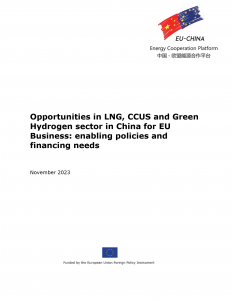
As the world accelerates away from current primary energy sources – oil and gas – development of substitutes is gathering pace. Competition for liquefied natural gas, which means fuel can be brought from a variety of sources with less reliance on geographical limitations has intensified in the wake of the Russia-Ukraine conflict. Meanwhile, countries worldwide are racing to develop green hydrogen and decarbonisation technologies such as carbon capture, utilisation and storage (CCUS) to mitigate emissions from the most polluting industries.
The EU-China Energy Cooperation Platform has commissioned a new report that offers an analysis of the three technologies in the EU and China, together with an assessment of how they can be included in the two regions’ energy markets, and an evaluation of opportunities for cooperation.
LNG is used as a buffer between strong global demand and a lagging supply, creating a seller’s market. Germany has moved quickly to substitute Russian gas with LNG imports, with new LNG terminals now planned. It is quite possible that Eastern European countries may follow suit, such as the Baltic States and Poland.
Meanwhile, China’s appetite for natural gas is on the rise, and the country is prioritising construction of new LNG import capacity, bringing it to 120 Mt/yr at 27 import terminals. LNG is now seen as a strategic resource, and is being used to stabilise the nation’s energy supplies, not merely as a response to domestic demand growth. New purchase contracts mean China is set to overtake Japan as the world’s largest LNG importer.
The significant connections already established between Chinese and foreign companies provide fertile ground for further cooperation, argues the report.
While hydrogen currently represents only a tiny fraction of the global energy mix, the nascent industry is set to play a pivotal role in improving the environmental impact of the energy sector and is a primary focus for industrialised countries. However, hydrogen produced from coal or natural gas with embedded CCS can only play a role during the transition period. The future is green hydrogen – hydrogen produced from renewable or nuclear electrolysis.
China and Europe have adopted very different approaches to hydrogen: China is prioritising the manufacturing approach, while the EU is focused on building a coherent regulatory and economic environment. While the EU has got off to a quick start, China’s rapid development of subsidies, as well as a regulation and legislation system, mean it is catching up rapidly.
China’s green hydrogen projects are now entering the 10 000 ton production stage, and state-owned enterprises have begun to promote hydrogen energy infrastructure planning. As China’s manufacturing capacity grows, the cost and price of hydrogen energy equipment is falling and is set to fall further, opening up the prospects for an affordable global green hydrogen industry.
In the EU, Hydrogen Valleys (geographically and industrially integrated areas where existing and future hydrogen applications are combined) are under development but face challenges associated with long permitting procedures, lack of technical knowledge in public administrations, and lack of legal framework.
Both the EU and China have released hydrogen-dedicated strategies, and recent developments in the industry offer promising signs of opportunities for cooperation between China and the EU in the areas of hydrogen value chain governance, supportive policy making, decarbonisation and industrial applications.
The report highlights the window of opportunity now open for the launch of innovative industrial partnerships between the EU and China which can be further developed when certification and market conditions have reached an acceptable level.
Recent developments in the CCUS industry have shown this suite of technologies to be safe, effective and scalable, and it is now regarded as central to decarbonisation of the world’s energy systems. It is the only technology offering low-carbon utilisation of fossil energy. In the EU, a new wave of projects is under way in 16 of its 27 Member States. In particular, the EU has developed technology to inject CO2 into natural underground reservoirs. China, meanwhile, recognises the key role of CCUS, but is facing challenges when it comes to achieving commercial-scale integrated CCUS projects, including high CO2 abatement costs, lack of effective business models, and insufficient incentives and regulatory measures.
Measures China could take now include: develop large-scale integrated CCS demonstration projects; integrate CCUS into China’s carbon market; adopt CCUS readiness design for all large stationary emission sources in China; increase R&D policy support for CCS technologies; and mitigate CO2 storage liability risk for early CCS demonstration projects.
CCUS is one of the most promising areas for international cooperation, argue the report authors, allowing companies and organisations to shoulder risks and costs together and better coordination, so delivering improved outcomes for all parties.
The report includes a list of China’s recent LNG purchase and sale agreements, and further lists of CCUS policies and demonstration projects in China.
Helen Farrell
Editor, ECECP
Download: PDF (5.79 MB)